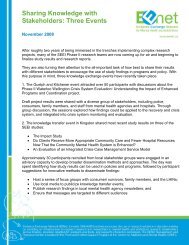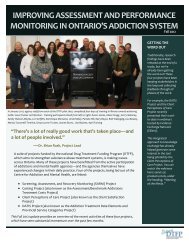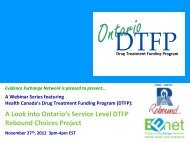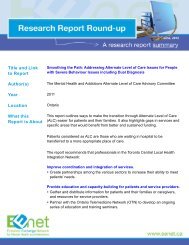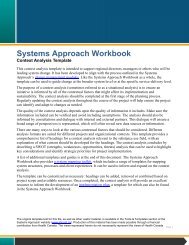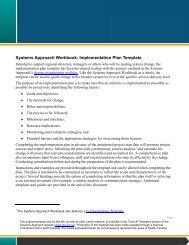Implementation of Early Psychosis Intervention Program ... - EENet
Implementation of Early Psychosis Intervention Program ... - EENet
Implementation of Early Psychosis Intervention Program ... - EENet
Create successful ePaper yourself
Turn your PDF publications into a flip-book with our unique Google optimized e-Paper software.
54Table 16: Procedures and protocol for anti-psychotic medications monitoringSurvey QuestionResponse (% yes)Q85: <strong>Program</strong> has written procedures for anti-psychotic medications monitoring 45Q86: Items in monitoring protocol:- Side effects 85- Metabolic disruption/wt gain 79- Blood work 69- Informed consent 65Main challenges to administering anti-psychotic medications noted by programs:o Cost <strong>of</strong> drugs for clients was noted by 64% <strong>of</strong> siteso Some sites mentioned: access to medical expertise (15%), medical support for clients under16 (10%); staff skills (8%); providing medical monitoring (15%).o Also noted by some sites were: client compliance and choices, lack <strong>of</strong> knowledge <strong>of</strong> EPIpractices among some medical pr<strong>of</strong>essionals, medications not being effective, and constraintsdue to staffing and psychiatry resources.Strategies suggested by programs for administering anti-psychotic medications:o Developing relationships with pharmaceutical company reps to obtain free drug samples anda compassionate supply.o Medications-related education and support for the client and family.o Nursing staff on EPI team; also <strong>of</strong>fering capacity to do injections in the home.What would help programs for administering low dose anti-psychotic medications:o Improved client access to drug benefits through existing programs such as ODSP andTrillium, & access to compassionate supply <strong>of</strong> medication if needed.o Education for health care pr<strong>of</strong>essionals working with EPI clients to be more knowledgeableabout best practices in EPI.o Prioritizing ongoing and consistent monitoring <strong>of</strong> clients for compliance and side effects.o Additional staffing and physician resources, and increased capacity to be able to <strong>of</strong>fer aninjectable service.4. Physical health monitoringStandard 3 outlines expectations related to ongoing medical assessment and general physicalhealth monitoring. This includes closely monitoring clients taking anti-psychotic medications forside effects, and addressing physical health issues in a timely fashion either directly or throughreferrals to other services.Summary <strong>of</strong> Results:o Overall moderate implementation <strong>of</strong> Standard related to physical health monitoring with 75%<strong>of</strong> programs reporting implementing this element ‘most <strong>of</strong> the time’; rates were somewhatlower in small program sites (57%).o Access to primary care (PC) physicians was identified as a challenge. 57% <strong>of</strong> program sitesoverall reported that most <strong>of</strong> their clients are followed by a primary care physician, and the



